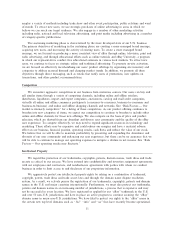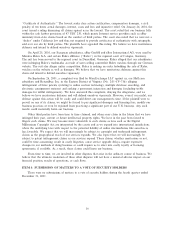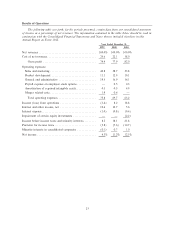eBay 2001 Annual Report Download - page 25
Download and view the complete annual report
Please find page 25 of the 2001 eBay annual report below. You can navigate through the pages in the report by either clicking on the pages listed below, or by using the keyword search tool below to find specific information within the annual report.been based on our assessment of the facts and circumstances at each balance sheet date and are subject to
change based upon new information and/or future events.
From time to time, we are involved in disputes that arise in the ordinary course of business, and we
do not expect this trend to change in the future. We are currently involved in certain legal proceedings as
discussed in ""Note 11 Ì Commitments and Contingencies Ì Litigation to the Consolidated Financial
Statements.'' We believe that we have meritorious defenses in the claims against us and we will defend
ourselves vigorously. However, even if successful, our defense against certain actions will be costly and
could divert our management's time. If the plaintiÅ's were to prevail on certain claims, we might be forced
to pay signiÑcant damages and licensing fees, modify our business practices or even be enjoined from
conducting a signiÑcant part of our U.S. business. Any such results could materially harm our business and
could result in a material adverse impact on our Ñnancial position, results of operations or cash Öows.
Impairment of Long-Lived Assets
Our long-lived assets at December 31, 2001, including property and equipment and goodwill and other
intangible assets, totaled $142.4 million and $198.6 million, respectively. In assessing the recoverability of
our goodwill and other intangible assets, we make assumptions regarding estimated future cash Öows and
other factors to determine the fair value of the respective assets. If these estimates or their related
assumptions change in the future, we may be required to record impairment charges to reduce the carrying
amount of these assets.
The fair value of long-term investments and restricted cash and investments are dependent on the
performance of the companies and instruments in which we have invested, as well as the volatility inherent
in external markets for these investments. In assessing potential impairment, we consider these factors as
well as the forecasted Ñnancial performance of our investee companies. If forecasted performance levels
are not met or if other events occur, we may have to record additional impairment charges to reduce the
carrying amount of these assets. During the year ended December 31, 2001, we recognized $16.2 million
of impairment losses relating to the impairment in value of certain equity investments. At December 31,
2001, the total value of our equity investments in unconsolidated companies was $26.7 million. See
""Note 17 Ì Subsequent Events to the Consolidated Financial Statements.''
Accounting for Income Taxes
We are required to recognize a provision for income taxes based upon the taxable income and
temporary diÅerences for each of the tax jurisdictions in which we operate. This process requires a
calculation of taxes payable under currently enacted tax laws around the world and an analysis of
temporary diÅerences between the book and tax bases of our assets and liabilities, including various
accruals, allowances, depreciation and amortization. The tax eÅect of these temporary diÅerences and the
estimated tax beneÑt from our tax net operating losses are reported as deferred tax assets and liabilities in
our consolidated balance sheet. We must also assess the likelihood that our net deferred tax assets will be
realized from future taxable income. To the extent we believe that it is more likely than not that some
portion or all of the deferred tax asset will not be realized, we must establish a valuation allowance. To the
extent we establish a valuation allowance or change the allowance in a period, we must reÖect the change
with a corresponding increase or decrease in our tax provision in our income statement. Where the change
in the valuation allowance relates to the deduction for employee stock option exercises, the change will be
reÖected as a credit to additional paid-in-capital. The net deferred tax asset net of a valuation allowance of
$129.2 million, totaled $35.2 million at December 31, 2001.
Other SigniÑcant Matters Impacting the Forecasting of Future Results
It is diÇcult for us to forecast revenues or earnings accurately, and the operating results in one or
more future quarters may fall below the expectations of securities analysts or investors. Although accurate
revenue forecasts are diÇcult, we believe that our business is seasonal as many of our users reduce their
activities on our website during the Thanksgiving (in the U.S.) and Christmas holidays, during national
21
























